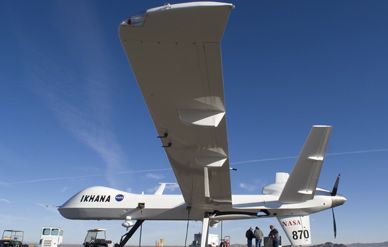"it has to be satellite-based or using repeating towers, which adds infrastructure and associated cost" - and
delay.
As far as I know, only two of us on this fine Site have any real experience with UAVs - my quoted comrade being the other - and there are many obstacles in the way of unmanned combat systems.
The delay between transmission and reception of satellite-routed signals is minor for simple communications, but critical when trying to direct machines involved in manoeuvering combat or dropping/launching on moving ground targets (USAF and RAF Predators and Reapers were operated locally for that reason), plus there is a huge lack of situational awareness when sitting in a ground control station compared to a cockpit.
As a Pilot, I relied on such things as peripheral vision, sound of my engine and transmission, and sensations of motion and vibration. As a CU161 Sperwer Mission Commander, I had none of those. We often only realized that we'd flown into a thunderstorm when either the thermal imager blanked out or the altimeter showed an almost-instantaneous drop of eight hundred feet or so, or both.
I lost three AVs in rapid succession during my tour in late-September 2008 to end-April 2009, one for a parachute failure during the recovery phase, one for an "AV close to stall speed" indication which turned out to be caused by a failure in one of two engine cylinders that was not obvious combined with the machine's automatic adoption of a climb attitude in its attempt to maintain altitude, and one for an engine-out indication which turned out to be nothing more than a fault of the RPM indicator system.
We almost lost another when the AV symbol on the moving-map display froze one night. We could still see with the thermal imager, but had no idea where we were as we did not know how long it had been since the problem occurred and when we noticed it. We were finally able to recognize Kandahar City and thus blunder our way back to Kandahar Airfield, but fine navigation was impossible - we actually inadvertently crossed the runway while setting up for one of many recovery attempts. Fortunately, this was late at night and there was no traffic around. We could not judge altitude, so relied on relayed information from ATC and altitude thus fluctuated wildly from several hundred feet below to several hundred feet above the specified recovery altitude. My PO (Payload Operator) could only look either ahead or down, but not both due to the narrowness of the thermal imager's field-of-view. That made it almost impossible to judge our proximity to the rather small recovery area, or even to line up on it. None of us had trained for a manual recovery. There was no means to do so, and it wasn't considered to be doable (recovery was by parachute, and the machine calculated wind drift effect to place itself in the correct position autonomously). When my AVO figured that we were in the best possible (or least-worst possible) position, he triggered the recovery process. We actually came down on the boundary between the recovery site and the uncleared minefield adjacent to it. Our relief was tremendous, and success was entirely due to the phenomenal co-ordination between my AVO and PO. While we, ourselves, were in no danger, there was a very real fear factor throughout
I read, much later (but still several years ago), a collection of UAV crews' disorientation experiences, including a Predator or Reaper that had somehow become inverted without the Pilot realizing it - he couldn't figure out why it was turning in the opposite direction to his control inputs. Many of those incidents resulted in loss of the machine, and I could well understand the problems and confusion that those guys had. I cannot find it online now, but it may have been a paper article. I did find the following four articles, which contain snippets of relevant information:
Up there or down here, it can be a struggle to maintain “situational awareness.”

www.airspacemag.com
At a desert facility, Air Force pilots are trained to fight America’s remote-controlled wars.

www.nytimes.com
https://www.theguardian.com/commentisfree/2013/dec/29/drones-us-military (I do not agree with all of the statements in this article)
https://apps.dtic.mil/dtic/tr/fulltext/u2/a543186.pdf (I've only skimmed this so far but will read in more detail later; I know Linda Bossi fairly well, and have enormous respect for her).
The Sperwer only had a thirteen-foot wingspan and was powered by a Rotax snowmobile engine, but we were told that it cost more per flying hour to operate than any other aircraft in the entire CF. It had a high loss rate (we were concerned that the Roto before us would not leave us any serviceable AVs by the time that they were finished) and, between the AVs, the Ground Control Stations (GCSs), Ground Data Terminals (GDTs), and other components, was a maintenance nightmare. There was an incredible number of minor/trivial malfunctions that could delay or scrub a mission or cause an AV loss.
Now, yes, this was ancient (and French) technology, but many of the same factors still exist, and will for several years to come.
AND DON'T CALL THEM "DR***S".
Please





